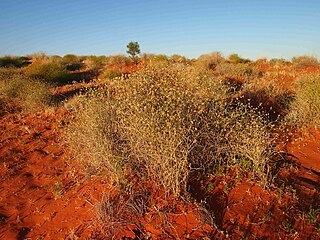
Cenchrus is a widespread genus of plants in the grass family. Its species are native to many countries in Asia, Africa, Australia, the Americas, and various oceanic islands.

Ruppia, also known as the widgeonweeds, ditch grasses or widgeon grass, is the only extant genus in the family Ruppiaceae, with eight known species. These are aquatic plants widespread over much of the world. The genus name honours Heinrich Bernhard Rupp, a German botanist (1688-1719). They are widespread outside of frigid zones and the tropics.

Triodia is a large genus of hummock-forming bunchgrass endemic to Australia. They are known by the common name spinifex, although they are not a part of the coastal genus Spinifex. Many of the soft-leaved members of this species were formerly included in the genus Plectrachne.

Zygochloa is a genus of desert plants in the grass family known only from Australia. The only known species is Zygochloa paradoxa, commonly known as sandhill canegrass. It occurs in extremely arid areas such as the Simpson Desert.

Chloris is a widespread genus of plants in the grass family, known generally as windmill grass or finger grass.

The flora of Australia comprises a vast assemblage of plant species estimated to over 20,000 vascular and 14,000 non-vascular plants, 250,000 species of fungi and over 3,000 lichens. The flora has strong affinities with the flora of Gondwana, and below the family level has a highly endemic angiosperm flora whose diversity was shaped by the effects of continental drift and climate change since the Cretaceous. Prominent features of the Australian flora are adaptations to aridity and fire which include scleromorphy and serotiny. These adaptations are common in species from the large and well-known families Proteaceae (Banksia), Myrtaceae, and Fabaceae.

Yakirra is a genus of Burmese and Australian plants in the grass family.
Ancistragrostis is a genus of Australian and New Guinean plants in the family Poaceae.
Arthragrostis is a genus of Australian plants in the grass family, found only in Queensland.
Austrofestuca, called beach fescue, is a genus of Australian and New Zealand plants in the grass family. The only accepted species is Austrofestuca littoralis, native to seacoast regions in Australia and New Zealand.
Clausospicula is a genus of Australian plants in the grass family. The only known species is Clausospicula extensa, native to Northern Territory.
Cyperochloa is a genus of Australian plants in the grass family. The only known species is Cyperochloa hirsuta, found in the Esperance Plains region of Western Australia.
Symplectrodia is a genus of Australian plants in the grass family.

Oxychloris is a genus of Australian plants in the grass family. The only known species is Oxychloris scariosa.

Eragrostiella is a genus of Asian, African, and Australian plants in the grass family.

Enteropogon is a genus of tropical and subtropical plants in the grass family. It is widespread across many parts of Asia, Africa, Australia, the Americas, and various islands.
Whiteochloa is a genus of plants in the grass family.
Hygrochloa is a genus of Australian plants in the grass family.
Micraira is the only genus of tribe Micraireae in the grass family, native to Australia.

Mnesithea, or jointtail grass, is a genus of Asian, Australian, and Pacific Island plants in the grass family.










